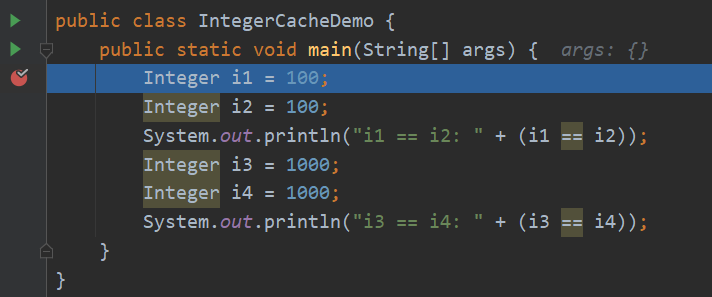100 == 100 ?, 1000 != 1000 ?
public class IntegerCacheDemo {
public static void main(String[] args) {
Integer i1 = 100;
Integer i2 = 100;
System.out.println("i1 == i2: " + (i1 == i2));
Integer i3 = 1000;
Integer i4 = 1000;
System.out.println("i3 == i4: " + (i3 == i4));
}
}
如代码所示:将常量 100 和 1000 分别赋予 i1、i2、i3、i4,运行得到的结果却是一个为 true 一个为 false:
i1 == i2: true
i3 == i4: false
在 IDEA 中设置断点,进入调试模式,Step Into:


可以看到在进行赋值操作时调用了 Integer.java 类下的 valueOf(int i) 方法,方法中 IntegerCache 为 Integer 的静态内部类:
private static class IntegerCache {
static final int low = -128;
static final int high;
static final Integer cache[];
static {
// high value may be configured by property
int h = 127;
String integerCacheHighPropValue =
sun.misc.VM.getSavedProperty("java.lang.Integer.IntegerCache.high");
if (integerCacheHighPropValue != null) {
try {
int i = parseInt(integerCacheHighPropValue);
i = Math.max(i, 127);
// Maximum array size is Integer.MAX_VALUE
h = Math.min(i, Integer.MAX_VALUE - (-low) -1);
} catch( NumberFormatException nfe) {
// If the property cannot be parsed into an int, ignore it.
}
}
high = h;
cache = new Integer[(high - low) + 1];
int j = low;
for(int k = 0; k < cache.length; k++)
cache[k] = new Integer(j++);
// range [-128, 127] must be interned (JLS7 5.1.7)
assert IntegerCache.high >= 127;
}
private IntegerCache() {}
}
观察到上图中 IntegerCache.low 的值为 -128,IntegerCache.high 的值可以通过JVM参数进行设置(-Djava.lang.Integer.IntegerCache.high=xxx),但若小于 127 则该值的设置无效,仍为 127,若太大(超过 Integer.MAX_VALUE - (128) - 1),则为 Integer.MAX_VALUE - (128) - 1。
故当直接对 Integer 对象赋值时,如 Integer i1 = x,如果 x 在 IntegerCache.low 和 IntegerCache.high 之间时,会直接返回 cache 数组中的 Integer 对象,此时显现出来的就是 100 == 100,而超过这个范围时,valueOf(int i) 方法会直接 new 一个新的 Integer 对象,显现出来的就是 1000 != 1000,本质上是因为前者比较的是同一个 Integer 对象,而后者比较的是不同的 Integer 对象。